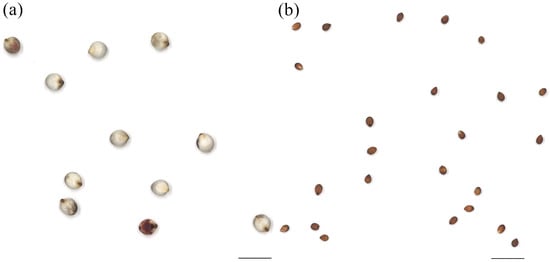Journal Description
Crops
Crops
is an international, peer-reviewed, open access journal on the science and technology of crops published quarterly online by MDPI.
- Open Access— free for readers, with article processing charges (APC) paid by authors or their institutions.
- Rapid Publication: manuscripts are peer-reviewed and a first decision is provided to authors approximately 30.5 days after submission; acceptance to publication is undertaken in 12.9 days (median values for papers published in this journal in the second half of 2023).
- Recognition of Reviewers: APC discount vouchers, optional signed peer review, and reviewer names published annually in the journal.
- Crops is a Companion Journal: Agriculture.
Latest Articles
A Genome-Wide Association Study of Seed Morphology-Related Traits in Sorghum Mini-Core and Senegalese Lines
Crops 2024, 4(2), 156-171; https://doi.org/10.3390/crops4020012 - 11 Apr 2024
Abstract
►
Show Figures
Sorghum (Sorghum bicolor L.) ranks fifth as the most crucial cereal crop globally, yet its seed morphology remains relatively unexplored. This study investigated seed morphology in sorghum based on 115 mini-core and 130 Senegalese germplasms. Eight seed morphology traits encompassing size, shape,
[...] Read more.
Sorghum (Sorghum bicolor L.) ranks fifth as the most crucial cereal crop globally, yet its seed morphology remains relatively unexplored. This study investigated seed morphology in sorghum based on 115 mini-core and 130 Senegalese germplasms. Eight seed morphology traits encompassing size, shape, and color parameters were assessed. Statistical analyses explored potential associations between these traits and resistance to three major sorghum diseases: anthracnose, head smut, and downy mildew. Furthermore, genome-wide association studies (GWAS) were conducted using phenotypic data from over 24,000 seeds and over 290,000 publicly available single nucleotide polymorphisms (SNPs) through the Genome Association and Prediction Integrated Tool (GAPIT) R package. Significant SNPs associated with various seed morphology traits were identified and mapped onto the reference sorghum genome to identify novel candidate defense genes.
Full article
Open AccessArticle
Hemp Seed Yield Responses to Nitrogen Fertility Rates
by
Swarup Podder, Sanaz Shafian, Wade E. Thomason, T. Bain Wilson and John H. Fike
Crops 2024, 4(2), 145-155; https://doi.org/10.3390/crops4020011 - 11 Apr 2024
Abstract
►▼
Show Figures
Industrial hemp (Cannabis sativa L.) holds promise as a crop for more sustainable supply chains given its potential as a source of high-strength fibers, adsorbents, and nutrient-dense feedstuffs. Developing nutrient management guidelines for hemp will be an important part of optimizing the
[...] Read more.
Industrial hemp (Cannabis sativa L.) holds promise as a crop for more sustainable supply chains given its potential as a source of high-strength fibers, adsorbents, and nutrient-dense feedstuffs. Developing nutrient management guidelines for hemp will be an important part of optimizing the crop’s sustainability attributes. This study measured hemp seed yield in response to N fertilization rate (0, 60, 120, 180, and 240 kg N ha−1). Treatments were tested with four hemp cultivars (‘Joey’ and ‘Grandi’ in 2020, 2021, and 2022 and ‘NWG 2463’ and ‘NWG 4113’ in 2023) in Virginia. Nitrogen input influenced (p ≤ 0.0177) seed yield in all four experimental years, although the pattern of response varied substantially. In 2020, following delayed seeding, hemp showed a weak quadratic (p = 0.0113) response to N inputs, with peak yield (1640 kg ha−1) occurring with 120 kg N ha−1. In 2021, hemp displayed a strong linear (p < 0.0001) response to N inputs, with the highest seed yield (2510 kg ha−1) at 240 kg N ha−1. In 2022, a season characterized by low precipitation and high weed pressure, a weak, linear (p = 0.0111) response to the N rate was observed. The greatest seed yield (380 kg ha−1) was again observed with 240 kg N ha−1. In 2023, weed pressure remained an issue, but the response to N was strong and linear (p < 0.0001), with the greatest seed yield (831 kg ha−1) again measured at 240 kg N ha−1. These findings indicate hemp can be quite responsive to N inputs but that the magnitude of response is sensitive to other factors such as available soil moisture, weed pressure, and growing period.
Full article
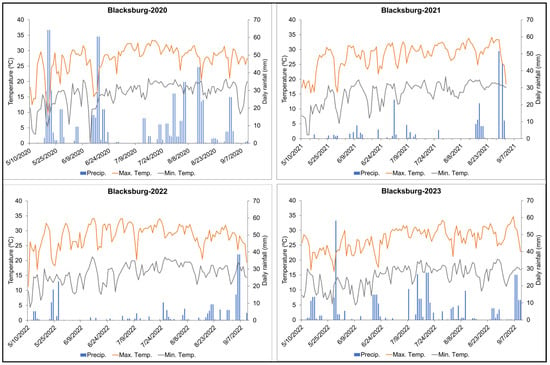
Figure 1
Open AccessArticle
Development of Algorithm for Determining N Fertiliser Requirements of Winter Wheat Based on N Status Using APSIM Modelling
by
Iris Vogeler, Uttam Kumar, Leif Knudsen, Elly M. Hansen, Val Snow and Ingrid K. Thomsen
Crops 2024, 4(2), 134-144; https://doi.org/10.3390/crops4020010 - 03 Apr 2024
Abstract
►▼
Show Figures
The determination of optimum nitrogen (N) fertilisation rates, which maximise yields and minimise N losses, remains problematic due to unknown upcoming crop requirements and near-future supply by the soil. Remote sensing can be used for determining the crop N status and to assess
[...] Read more.
The determination of optimum nitrogen (N) fertilisation rates, which maximise yields and minimise N losses, remains problematic due to unknown upcoming crop requirements and near-future supply by the soil. Remote sensing can be used for determining the crop N status and to assess the spatial variability within a field or between fields. This can be used to improve N fertilisation, provided that the optimal fertilisation rate at the time of fertiliser application for an expected yield is known. Using the APSIM-wheat model, we developed an algorithm that relates the N status of the plants at early development stages to the yield response to N. Simulations were performed for winter wheat under growth conditions in Denmark. To obtain a range of different N status in the biomass at early growth stages, the soil N in autumn was varied from 20 to 180 kg N ha−1, and at BBCH23, fertiliser was applied at a rate of 50 kg N ha−1. In a full factorial setup, additional N fertiliser was applied ranging from 0 to 150 kg N ha−1 during three different development stages (BBCH30, 32, and 37). The algorithm was evaluated by comparing model outputs with a standard N application of 50 kg N ha−1 at BBCH23 and 150 kg N ha−1 at BBCH30. The evaluation showed that, depending on the N status of the soil, the algorithm either provided higher or lower optimal N fertilisation rates when targeting 95% of the maximum yield, and these affected the grain yield and the grain N, as well as the amount of N leaching. Split application of fertiliser into three applications was generally beneficial, with decreased product-related N leaching of up to nearly 30%. Further testing of the model under different environmental conditions is needed before such an algorithm can be used to guide N fertilisation.
Full article

Figure 1
Open AccessArticle
Analyzing Winter Wheat (Triticum aestivum) Growth Pattern Using High Spatial Resolution Images: A Case Study at Lakehead University Agriculture Research Station, Thunder Bay, Canada
by
María V. Brenes Fuentes, Muditha K. Heenkenda, Tarlok S. Sahota and Laura Segura Serrano
Crops 2024, 4(2), 115-133; https://doi.org/10.3390/crops4020009 - 28 Mar 2024
Abstract
Remote sensing technology currently facilitates the monitoring of crop development, enabling detailed analysis and monitoring throughout the crop’s growing stages. This research analyzed the winter wheat growth dynamics of experimental plots at the Lakehead University Agricultural Research Station, Thunder Bay, Canada using high
[...] Read more.
Remote sensing technology currently facilitates the monitoring of crop development, enabling detailed analysis and monitoring throughout the crop’s growing stages. This research analyzed the winter wheat growth dynamics of experimental plots at the Lakehead University Agricultural Research Station, Thunder Bay, Canada using high spatial and temporal resolution remote sensing images. The spectral signatures for five growing stages were prepared. NIR reflectance increased during the growing stages and decreased at the senescence, indicating healthy vegetation. The space–time cube provided valuable insight into how canopy height changed over time. The effect of nitrogen treatments on wheat did not directly influence the plant count (spring/autumn), and height and volume at maturity. However, the green and dry weights were different at several treatments. Winter wheat yield was predicted using the XGBoost algorithm, and moderate results were obtained. The study explored different techniques for analyzing winter wheat growth dynamics and identified their usefulness in smart agriculture.
Full article
(This article belongs to the Special Issue Fertigation and Nutrient Management in Crops)
►▼
Show Figures
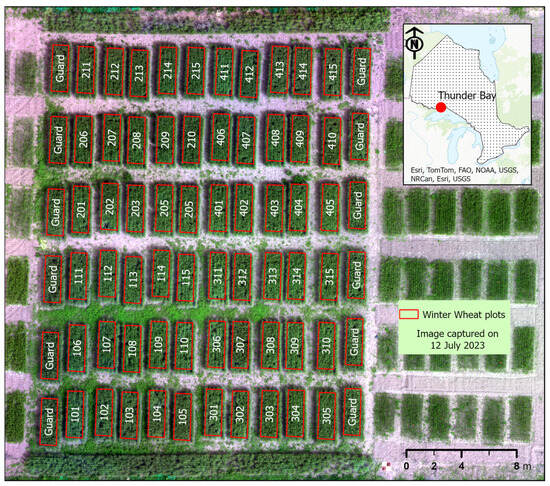
Figure 1
Open AccessReview
The Potential of Cold Plasma-Based Seed Treatments in Legume–Rhizobia Symbiotic Nitrogen Fixation: A Review
by
Dhanuja N. Abeysingha, Harleen K. Dhaliwal, Lihui Du, Chathuranga De Silva, Krzysztof Szczyglowski, M. S. Roopesh and Malinda S. Thilakarathna
Crops 2024, 4(1), 95-114; https://doi.org/10.3390/crops4010008 - 11 Mar 2024
Abstract
The use of cold plasma (CP) seed treatment is an emerging agricultural technology that exhibits the potential to enhance nodulation and symbiotic nitrogen fixation (SNF) in legumes. CP is composed of a diverse mixture of excited atoms, molecules, ions, and radicals that have
[...] Read more.
The use of cold plasma (CP) seed treatment is an emerging agricultural technology that exhibits the potential to enhance nodulation and symbiotic nitrogen fixation (SNF) in legumes. CP is composed of a diverse mixture of excited atoms, molecules, ions, and radicals that have the potential to affect the physical properties of the seed and influence gene expressions that could have a lasting impact on the nodulation, SNF, growth, and yield of legumes. The direct participation of the CP in the nodulation process and its correlation with the escalation of nodules and SNF is still not fully understood. This review discussed four areas in the nodulation and SNF process that can directly or indirectly affect CP seed treatments: root–rhizobia signal exchange pathways, root/shoot growth and development, phytohormone production, and the nitrogen fixation process. We also discuss the potential challenges and future research requirements associated with plasma technology to enhance SNF in legumes.
Full article
(This article belongs to the Topic Emerging Agricultural Engineering Sciences, Technologies, and Applications—2nd Edition)
►▼
Show Figures
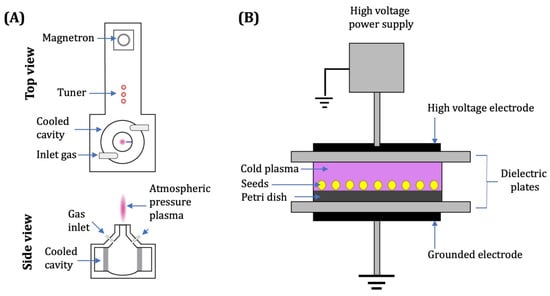
Figure 1
Open AccessArticle
Optimizing Soybean Crop Performance through the Integrated Application of Organic and Chemical Fertilizers: A Study on Alkaline Soil in Afghanistan
by
Abdul Basir Turabi, Safiullah Habibi, Kifayatullah Kakar, Shafiqullah Aryan, Mohammad Daud Haidari and Sabqatullah Alipour
Crops 2024, 4(1), 82-94; https://doi.org/10.3390/crops4010007 - 07 Mar 2024
Abstract
The excess application of chemical fertilizer contributes to environmental pollution. Therefore, this study aims to explore the integrated use of animal manure and chemical fertilizer to identify a more sustainable and environmentally friendly alternative to nitrogen fertilizer. Two experiments were conducted in 2018
[...] Read more.
The excess application of chemical fertilizer contributes to environmental pollution. Therefore, this study aims to explore the integrated use of animal manure and chemical fertilizer to identify a more sustainable and environmentally friendly alternative to nitrogen fertilizer. Two experiments were conducted in 2018 and 2019 at Kabul University, Afghanistan, using an LD04-13265 soybean variety. The integration of animal manure and chemical fertilizer was categorized into six treatments: (1) control (no fertilizer), (2) animal manure low dose (AMLD), (3) animal manure high dose (AMHD), (4) chemical fertilizer (CF), (5) CF 50% + AMLD, and (6) CF 75% + AMLD. The results revealed that AMHD and its integration with 75% chemical fertilizer greatly influenced the vegetative growth of soybean plants in experiments I and II. The number of pods per plant and pod length significantly (p < 0.05) increased under the CF 75% + AMLD treatment. In experiment I, soybean yield increased the most with the CF treatment, followed by CF 75% + AMLD. In contrast, in experiment II, the highest yield per hectare was observed in the CF 75% + AMLD treatment, followed by CF. The CF 75% + AMLD treatment significantly increased the SPAD value in both experiments. Consequently, a strong relationship was observed between the SPAD value and yield (r = 0.74) in experiment I and between SPAD and pod length (r = 0.82) in experiment II. Incorporating animal manure with chemical fertilizer significantly impacted soybean growth and yield, offering a potential possibility for reducing reliance on nitrogen fertilizer application to mitigate environmental pollution.
Full article
(This article belongs to the Topic Plants Nutrients, 2nd Volume)
►▼
Show Figures
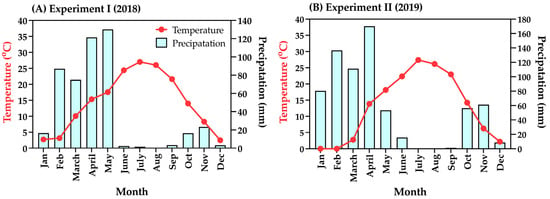
Figure 1
Open AccessArticle
Comparison of the Nutritional Composition of Quinoa (Chenopodium quinoa Willd.) Inflorescences, Green Leaves, and Grains
by
Safiullah Pathan, Grato Ndunguru and Addissu G. Ayele
Crops 2024, 4(1), 72-81; https://doi.org/10.3390/crops4010006 - 29 Feb 2024
Abstract
►▼
Show Figures
The nutritional composition of different parts of quinoa (Chenopodium quinoa Willd.), such as sprouts, green leaves, and grains, have previously been studied in detail. This study aimed to compare the nutritional values of quinoa inflorescences against those of quinoa leaves and grains.
[...] Read more.
The nutritional composition of different parts of quinoa (Chenopodium quinoa Willd.), such as sprouts, green leaves, and grains, have previously been studied in detail. This study aimed to compare the nutritional values of quinoa inflorescences against those of quinoa leaves and grains. The assessment of nutritional composition includes crude protein, crude fat, fiber, ash, carbohydrates, essential amino acids, and minerals. The proximate analysis showed that on a dry weight (DW) basis, quinoa inflorescences contain higher amounts of protein, fiber, all essential amino acids, and minerals when compared to quinoa grains. However, quinoa green leaves have higher protein and fat contents than quinoa inflorescences, while retaining all essential amino acids and minerals. Inflorescences possess a higher fiber content and a lower fat content than green leaves and grains do. In this study, nutritional assessments of inflorescences typically ranked in the middle when compared to those of green leaves and grains. These findings emphasize the nutritional potential of quinoa inflorescences as prospective ingredients to develop healthy foods and supplements that provide health benefits beyond basic nutritional functions. Nevertheless, additional research is essential to confirm and substantiate these results.
Full article
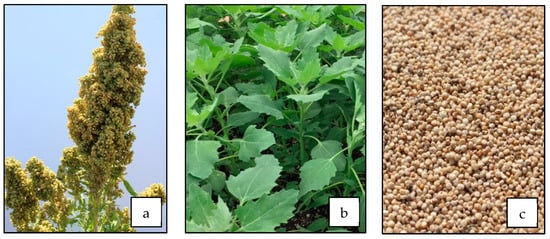
Figure 1
Open AccessArticle
Comparative Growth of Elephant Ear Taro (Alocasia macrorrhiza) and Giant Swamp Taro (Cyrtosperma merkusii) in Hawai‘i
by
Thathmini D. Kularatna, Norman Q. Arancon and Jesse A. Eiben
Crops 2024, 4(1), 55-71; https://doi.org/10.3390/crops4010005 - 18 Feb 2024
Abstract
►▼
Show Figures
Alocasia macrorrhiza and Cyrtosperma merkusii are root crops in the family Araceae that have the potential to be grown as fodder plants in Hawai‘i. This research focused on growing C. merkusii and two varieties (Laufola and Faitama) of A. macrorrhiza to evaluate their
[...] Read more.
Alocasia macrorrhiza and Cyrtosperma merkusii are root crops in the family Araceae that have the potential to be grown as fodder plants in Hawai‘i. This research focused on growing C. merkusii and two varieties (Laufola and Faitama) of A. macrorrhiza to evaluate their growth and yield. A randomized complete block design was used to set up two growth trials in 2018 and 2019. Varieties were grown in pots in the first trial and directly on the ground in the second trial. Plant growth was measured weekly by the plant height and leaf area of the main plants. The weights of the leaf blades, petioles, and stems were taken as the yield. Lateral plants and their weights were also measured. The yield data at harvest were statistically analyzed with a one-way ANOVA in PROC GLM, and means were separated using a Post-hoc test, Least Significant Difference, at 5%. The influence of plant height, leaf area, number of leaves produced by main plants, number of lateral plants, and their total weight on yield were analyzed by Pearson’s correlation coefficient. The growth and yield of plants in the second trial were generally superior to those in the first trial, in which the Laufola variety had the highest growth increase in height and leaf area, followed by Faitama. Those varieties of A. macrorrhiza also had the highest yields. The Laufola variety had the greatest average yield, in kg/ha estimates of the stem (54,896 kg/ha), petiole (99,647 kg/ha), and leaf blades (25,563 kg/ha). Plant height, leaf area, and the number of leaves produced by the main plants had a strong positive influence on the yields. Laufola and Faitama varieties have better potential to be grown in Hilo, Hawai‘i.
Full article
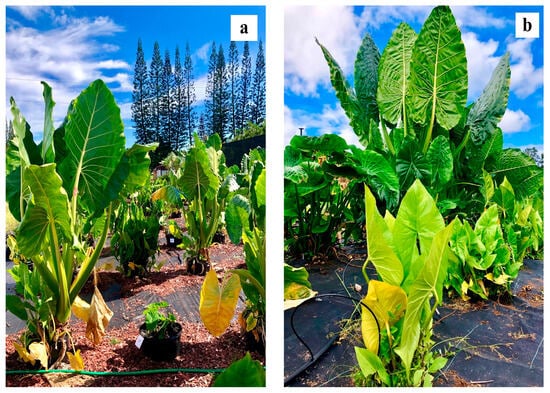
Figure 1
Open AccessReview
Root Exudate Metabolites Alter Food Crops Microbiomes, Impacting Plant Biocontrol and Growth
by
Shimaila Ali and Bernard R. Glick
Crops 2024, 4(1), 43-54; https://doi.org/10.3390/crops4010004 - 08 Feb 2024
Abstract
Exuded plant metabolites play an important role in fostering beneficial interactions with the surrounding soil microbiota, thereby helping plants to better adjust to changing environmental conditions. These metabolites act as signals to attract or enhance the colonization of plant roots with specific groups
[...] Read more.
Exuded plant metabolites play an important role in fostering beneficial interactions with the surrounding soil microbiota, thereby helping plants to better adjust to changing environmental conditions. These metabolites act as signals to attract or enhance the colonization of plant roots with specific groups of beneficial microbes and they modulate the dynamics of plant–microbe interactions in fulfilling plant niche-based requirements, directly and/or indirectly. This review emphasizes the expression, levels, modes of action, and net effects of the signaling metabolites that help food crop plants to become colonized by microbes that promote plant growth and development under periods of biotic stress.
Full article
(This article belongs to the Special Issue Biological Control in Food Crops)
►▼
Show Figures

Figure 1
Open AccessArticle
Efficacy and Differential Physiological–Biochemical Response of Biostimulants in Green Beans Subjected to Moderate and Severe Water Stress
by
Karla I. Hernández-Figueroa, Esteban Sánchez, Carlos A. Ramírez-Estrada, Julio C. Anchondo-Páez, Damaris L. Ojeda-Barrios and Sandra Pérez-Álvarez
Crops 2024, 4(1), 27-42; https://doi.org/10.3390/crops4010003 - 12 Jan 2024
Abstract
Water stress is one of the main factors affecting the development of agricultural crops. An innovative alternative to improve tolerance to water stress is the application of biostimulants. In the present study, the efficacy and physiological and biochemical responses of different biostimulants were
[...] Read more.
Water stress is one of the main factors affecting the development of agricultural crops. An innovative alternative to improve tolerance to water stress is the application of biostimulants. In the present study, the efficacy and physiological and biochemical responses of different biostimulants were evaluated in beans under moderate and severe stress. The treatments consisted of three types of irrigation: FC100, without water stress; FC75, irrigation reduced by 25% (moderate water stress); and FC50, irrigation reduced by 50% (severe water stress). In the treatments with water deficits, foliar biostimulants were applied: zinc oxide nanoparticles plus chitosan, Codasil®, Osmoplant®, Stimplex® and salicylic acid. Foliar application of ZnO + chitosan nanoparticles benefited biomass accumulation and yield under moderate water stress (FC75) and Codasil® and Osmoplant® under severe water stress (FC50). Proline, free sugars and gas exchange were higher with the application of ZnO + chitosan nanoparticles under moderate water stress and with Codasil® and Osmoplant® under severe water stress. Depending on the severity of water stress, ZnO + chitosan nanoparticles, Codasil® and Osmoplant® are viable products to increase tolerance in green bean cv. Strike plants.
Full article
(This article belongs to the Special Issue Effect of Drought Stress on Nutrient Management in Crop Plant Production)
►▼
Show Figures
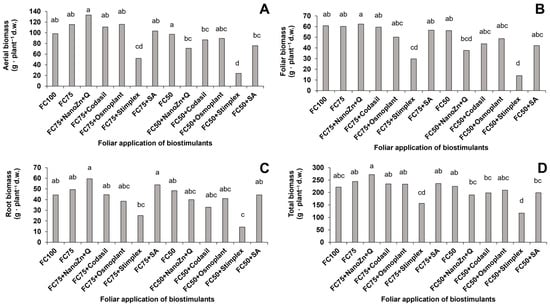
Figure 1
Open AccessArticle
Lodging Variability in Sorghum Stalks Is Dependent on the Biomechanical and Chemical Composition of the Stalk Rinds
by
Endalkachew Mengistie, Norbert Bokros, Seth DeBolt and Armando G. McDonald
Crops 2024, 4(1), 3-26; https://doi.org/10.3390/crops4010002 - 11 Jan 2024
Abstract
►▼
Show Figures
Stalk lodging contributes to significant crop yield losses. Therefore, understanding the biomechanical strength and structural rigidity of grain stalks can contribute to improving stalk lodging resistance in crops. From the structural constituents of the stalk, the rind provides the principal structure, supporting cells
[...] Read more.
Stalk lodging contributes to significant crop yield losses. Therefore, understanding the biomechanical strength and structural rigidity of grain stalks can contribute to improving stalk lodging resistance in crops. From the structural constituents of the stalk, the rind provides the principal structure, supporting cells against tension and bending loads. In this work, the biomechanical and viscoelastic behavior of the rind from the internodes of two sweet sorghum varieties (Della and REDforGREEN (RG)), grown in two different growing seasons, were evaluated by three-point micro-bending tests using a dynamic mechanical analyzer (DMA). In addition, the chemical composition of rinds and the microfibril angle (MFA) of the cell wall were determined using XRD. The results revealed that the biomechanical behavior of Della varieties was stiffer and more resistant to loads than that of RG varieties. Two features of the rind biomechanical properties, flexural modulus (FM) and flexural strength (FS), showed a significant reduction for RG. Particularly, a reduction in FS of 16–37% and in FM of 22–41% were detected for RG1. Changes in the stalks’ rind biomechanical properties were attributed to cell wall components. Total lignin and glucan/cellulose contents were positively correlated with the FM and FS of the rind. Subsequently, an increase in the two cell wall components drove an increase in stiffness. Furthermore, the MFA of the rind was also found to influence the rind strength.
Full article
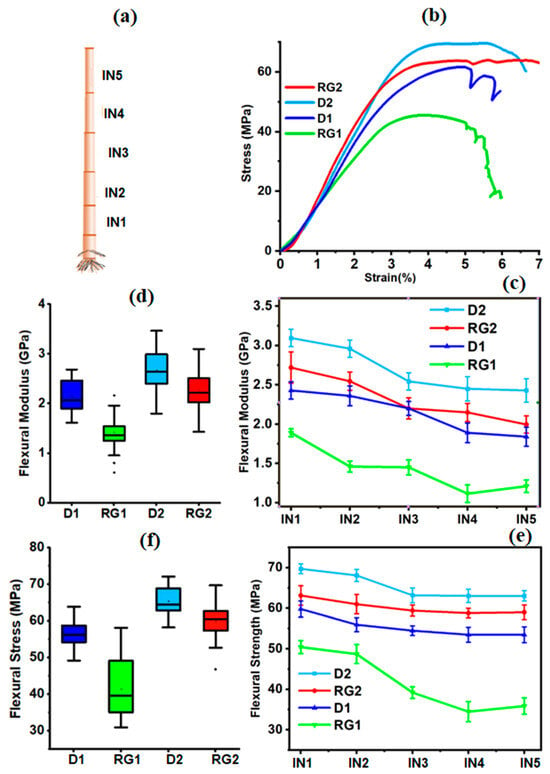
Figure 1
Open AccessEditorial
Crops: A Growing Global Community of Crop Scientists
by
Kenneth J. Moore
Crops 2024, 4(1), 1-2; https://doi.org/10.3390/crops4010001 - 03 Jan 2024
Abstract
It has been two years since the inaugural issue of Crops was published [...]
Full article
Open AccessArticle
Identification of High-Yielding Soybean Lines with Exceptional Seed Composition Qualities
by
Jay Gillenwater, Rouf Mian, Mia Cunicelli, Brant McNeece and Earl Taliercio
Crops 2023, 3(4), 333-342; https://doi.org/10.3390/crops3040029 - 13 Dec 2023
Abstract
►▼
Show Figures
In current markets, the primary uses for soybean seeds are in products derived from their oil or protein content. However, growers are compensated based on seed yield, so a more valuable crop is one that does not compromise on yield when compared with
[...] Read more.
In current markets, the primary uses for soybean seeds are in products derived from their oil or protein content. However, growers are compensated based on seed yield, so a more valuable crop is one that does not compromise on yield when compared with existing options, with an optimum combination of protein and oil. A negative correlation of seed protein with seed yield and oil makes the simultaneous improvement of these traits difficult but not impossible through conventional breeding. Selections of lines with exceptional yield and seed composition were made from two recombinant inbred line (RIL) soybean mapping populations to identify high protein and/or high oil lines with yields comparable to elite cultivars. The performance of these RILs was evaluated in multiple environments, and several genotypes were identified with yields comparable to those of high-yielding check cultivars with seed protein and/or oil content superior to the checks. These genotypes will provide breeders with additional sources of germplasm for continuing efforts to improve seed composition traits without compromising seed yield and provide growers with more profitable cultivars.
Full article
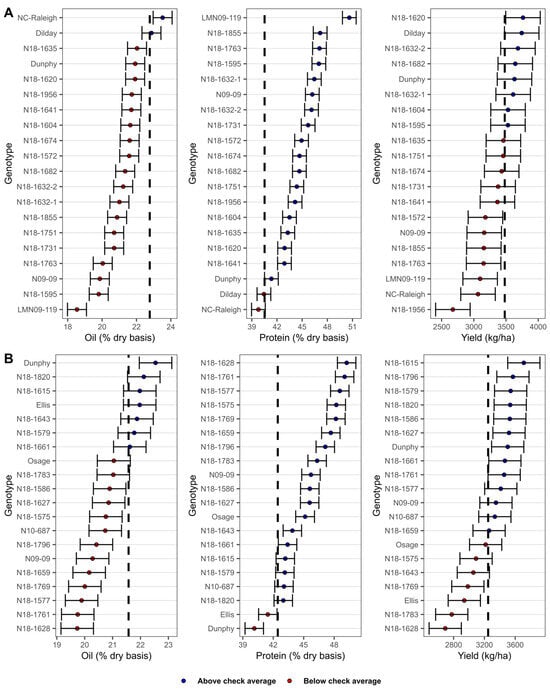
Figure 1
Open AccessArticle
Marker Development and Pyramiding of Fhb1 and Fhb7 for Enhanced Resistance to Fusarium Head Blight in Soft Red Winter Wheat
by
Binod Gyawali, Steven R. Scofield and Mohsen Mohammadi
Crops 2023, 3(4), 320-332; https://doi.org/10.3390/crops3040028 - 07 Dec 2023
Abstract
►▼
Show Figures
Fusarium head blight (FHB) is a devastating fungal disease of hexaploid wheat (Triticum aestivum). Several genetic loci were previously identified that control FHB resistance in wheat, including Fhb1. Fhb7, a major QTL conferring resistance to FHB, controlling for mycotoxin
[...] Read more.
Fusarium head blight (FHB) is a devastating fungal disease of hexaploid wheat (Triticum aestivum). Several genetic loci were previously identified that control FHB resistance in wheat, including Fhb1. Fhb7, a major QTL conferring resistance to FHB, controlling for mycotoxin deoxynivalenol (DON) production, has been introgressed into soft red winter wheat (SRWW). As an exotic QTL, Fhb7 is associated with linkage drag, affecting agronomic and end-use quality performance. This study outlines a breeding strategy for introducing and pyramiding Fhb7 into SRWW breeding populations that already possessed Fhb1 and harbored some additional disease-resistance genes. In addition to the Fhb1-Fhb7 pyramiding, we developed gene-based markers for both genes and examined them on 57 SRWW breeding lines. Our data showed that 15 out of 57 breeding lines possessed both Fhb1 and Fhb7 resistant alleles. Two years of phenotypic data from the inoculated and misted irrigation field showed that the combination of Fhb1-Fhb7 lowers mycotoxin DON accumulation in kernels, which provides protection for end-users and the milling industry. The Fhb gene-pyramided lines, with the additional regionally important disease resistance genes, produced in this breeding pipeline showed reasonable agronomic traits and can be used in crossing programs for the widespread introgression in elite wheat cultivars.
Full article

Figure 1
Open AccessArticle
Molecular Discrimination and Phylogenetic Relationships of Physalis Species Based on ITS2 and rbcL DNA Barcode Sequence
by
Katherine Pere, Kenneth Mburu, Edward K. Muge, John Maina Wagacha and Evans N. Nyaboga
Crops 2023, 3(4), 302-319; https://doi.org/10.3390/crops3040027 - 17 Nov 2023
Abstract
►▼
Show Figures
Plants of the genus Physalis are of economic interest because of their fleshy edible fruits with high nutritional value. Some species have high medicinal value with a long history of ethno-medicinal use to treat diverse diseases. There is therefore a need to correctly
[...] Read more.
Plants of the genus Physalis are of economic interest because of their fleshy edible fruits with high nutritional value. Some species have high medicinal value with a long history of ethno-medicinal use to treat diverse diseases. There is therefore a need to correctly discriminate the different species of Physalis for proper utilization. Although most Physalis species have unique morphologies, their vegetative stages are identical, making it difficult to accurately identify them based on morphological characteristics. DNA barcoding has the potential to discriminate species accurately. In this study, ribulose bisphosphate carboxylase large (rbcL) and internal transcribed spacer 2 (ITS2) regions were used to discriminate Physalis species and to reveal their phylogenetic relationships and genetic diversity. Physalis plant samples were collected from seven counties in Kenya based on the availability of the germplasm. The voucher specimens were identified using the botanical taxonomy method and were deposited in the University of Nairobi herbarium. Genomic DNA was isolated from leaf samples of 64 Physalis accessions and used for PCR amplification and the sequencing of rbcL and ITS2 barcode regions. The discriminatory ability of the barcodes was based on BLASTn comparison, phylogenetic reconstruction and cluster analysis, and the determination of inter- and intra-specific distances. The nucleotide polymorphism, genetic diversity and distance of the identified Physalis species were determined using DnaSP and MEGA 11.0 software. Species discrimination was more robust using ITS2 sequences. The species identified and discriminated by ITS2 sequences were Physalis purpurea, Physalis peruviana and Physalis cordata. The rbcL sequences were only able to identify Physalis to the genus level. There was high interspecific and low intraspecific divergence within the identified Physalis species based on ITS2 sequences. The ITS2 barcode is an ideal DNA barcode for use in the discrimination of species, as well as in genetic diversity studies of Physalis accessions in Kenya.
Full article
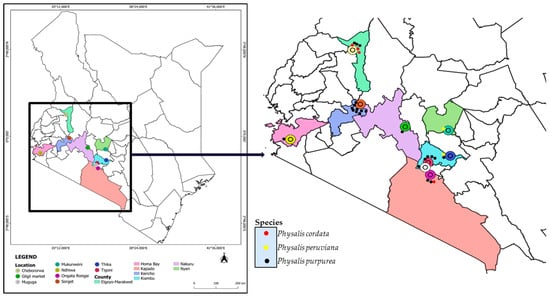
Figure 1
Open AccessArticle
Herbicide Program to Control Parthenium hysterophorus in Grain Sorghum in an Arid Environment
by
Ali Ahsan Bajwa, Ahmad Nawaz, Muhammad Farooq, Bhagirath Singh Chauhan and Steve Adkins
Crops 2023, 3(4), 292-301; https://doi.org/10.3390/crops3040026 - 16 Nov 2023
Abstract
Parthenium weed (Parthenium hysterophorus L.) is an emerging production constraint in many summer crops including sorghum (Sorghum bicolor L. Moench), but limited control options are available. In this field study, the efficacy of sole and sequential applications of a pre-emergence (pendimethalin)
[...] Read more.
Parthenium weed (Parthenium hysterophorus L.) is an emerging production constraint in many summer crops including sorghum (Sorghum bicolor L. Moench), but limited control options are available. In this field study, the efficacy of sole and sequential applications of a pre-emergence (pendimethalin) and a post-emergence (bromoxynil) herbicide was evaluated for parthenium weed control in grain sorghum over two years. Pendimethalin or bromoxynil alone could only provide 54% and 63% control, whereas their sequential application provided 86% control of parthenium weed over the weedy treatment. The sorghum plants in pendimethalin followed by bromoxynil treatment had the highest leaf fresh weight per plant, plant dry biomass, plant height, and the number of heads among the herbicide treatments. Sorghum fresh forage yield, dry fodder yield, 1000-grain weight, and grain yield were highest in the weed-free treatment followed by the pendimethalin followed by (fb) bromoxynil treatment. Overall, the herbicide treatment performance was in an order of pendimethalin fb bromoxynil > bromoxynil > pendimethalin for weed control and sorghum yield improvement. These results suggest that pendimethalin followed by bromoxynil may provide acceptable control (>85%) of parthenium weed and may improve sorghum grain yield (up to 23%).
Full article
(This article belongs to the Topic Weed Resistance to Herbicides: Assessing and Finding Solutions for a Complex Problem)
►▼
Show Figures
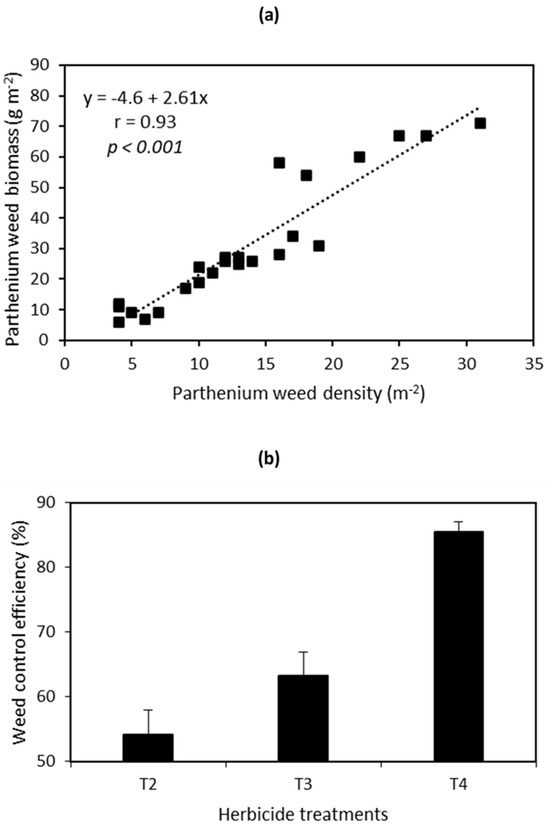
Figure 1
Open AccessReview
Speed Breeding for Crop Improvement and Food Security
by
Jesse Potts, Sumit Jangra, Vincent N. Michael and Xingbo Wu
Crops 2023, 3(4), 276-291; https://doi.org/10.3390/crops3040025 - 03 Nov 2023
Cited by 2
Abstract
Amid a rapidly growing global population and increasing threats to crop yields, this review focuses on Speed Breeding (SB) in crop genetics. It traces SB’s development from carbon arc lamp experiments 150 years ago to its modern use with LED technology which significantly
[...] Read more.
Amid a rapidly growing global population and increasing threats to crop yields, this review focuses on Speed Breeding (SB) in crop genetics. It traces SB’s development from carbon arc lamp experiments 150 years ago to its modern use with LED technology which significantly accelerates breeding cycles. SB has applications in genetic mapping, genetic modification, and trait stacking, enhancing crop resilience by leveraging allelic diversity. It aligns well with breeding methods like single plant selection and single seed descent. The integration of SB with gene editing, genotyping, and genomic selection holds great promise. However, SB faces challenges related to infrastructure, genotypic variations, and potential stress responses. In summary, SB is a powerful and promising approach to address food security concerns and advancing crop genetics.
Full article
(This article belongs to the Special Issue Ensuring Food Security in a Changing World)
►▼
Show Figures
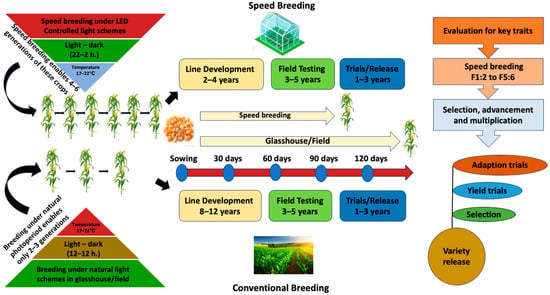
Figure 1
Open AccessArticle
Pearl Millet-Cowpea Forage Mixture Planting Arrangement Influences Mixture Yield and Nutritive Value in Semiarid Regions
by
Leonard M. Lauriault, Murali K. Darapuneni and Gasper K. Martinez
Crops 2023, 3(4), 266-275; https://doi.org/10.3390/crops3040024 - 29 Oct 2023
Abstract
Pearl millet (Pennisetum glaucum (L.) R. Br.) and cowpea (Vigna unguiculata L. Walp.) are well-adapted to semiarid regions. A two-year study at New Mexico State University’s Rex E. Kirksey Agricultural Science Center at Tucumcari, NM, USA, compared monoculture pearl millet and
[...] Read more.
Pearl millet (Pennisetum glaucum (L.) R. Br.) and cowpea (Vigna unguiculata L. Walp.) are well-adapted to semiarid regions. A two-year study at New Mexico State University’s Rex E. Kirksey Agricultural Science Center at Tucumcari, NM, USA, compared monoculture pearl millet and cowpea with their mixtures in various row arrangements in four randomized complete blocks each year. Treatments included monoculture pearl millet (millet) and cowpea (cowpea), pearl millet and cowpea mixture planted in the same row (millet–cowpea), the species planted in alternate rows (millet–cowpea 1:1), the species planted in two adjacent rows alternating between species (millet–cowpea 2:2), and the species planted in four adjacent rows alternating between species (millet–cowpea 4:4), Mixture neutral detergent fiber (NDF) was reduced i millet–cowpea 1:1 and millet–cowpea 2:2 compared to millet (673, 662, 644, 646, and 666 g NDF kg−1 for millet, millet–cowpea, millet–cowpea 1:1, millet–cowpea 2:2, and millet–cowpea 4:4, respectively, LSD = 18, p ≤ 0.05). Crude protein tended to be increased in millet–cowpea 2:2. Based on these results two rows of cowpea alternated with two rows of pearl millet, all spaced at 15 cm and harvesting for hay at the pearl millet boot stage likely optimizes the compromise of DM yield and the nutritive value of the mixture.
Full article
(This article belongs to the Special Issue Fertigation and Nutrient Management in Crops)
Open AccessArticle
Tomato Firmness and Shelf-Life Increased by Application of Stimulated Calcium
by
Jolyon Dodgson, Anna K. Weston and David J. Marks
Crops 2023, 3(4), 251-265; https://doi.org/10.3390/crops3040023 - 23 Oct 2023
Abstract
Tomato (Solanum lycopersicum L.) had almost 190 million tonnes produced in 2021. Tomato fruit suffer losses of up to 50% during harvest and transport, which causes financial hardship, reduces the amount of food available and causes environmental harm. Calcium plays an important
[...] Read more.
Tomato (Solanum lycopersicum L.) had almost 190 million tonnes produced in 2021. Tomato fruit suffer losses of up to 50% during harvest and transport, which causes financial hardship, reduces the amount of food available and causes environmental harm. Calcium plays an important role in cell wall strength. This work assessed the use of a calcium transport stimulant (MCAS) to increase the firmness of tomato fruit in the laboratory and the foliar application to tomato plants. Then, handling damage was simulated. In the laboratory, the calcium with MCAS significantly increased the fruit firmness compared to the untreated and calcium without MCAS, which were not significantly different. When calcium with MCAS was applied to tomato plants foliarly before harvest, the calcium with MCAS-treated fruit were significantly firmer than the untreated or calcium without MCAS-treated fruit for up to 10 weeks after harvest, and this was achieved by applying only 0.91 kg ha−1 calcium. Finally, when fruit were exposed to a simulated drop, the calcium with MCAS-treated fruit remained firmer than the undamaged fruit or dropped fruit with calcium without MCAS. Calcium with MCAS could significantly increase the fruit firmness and increase the shelf-life of tomatoes while applying less calcium.
Full article
(This article belongs to the Topic Plants Nutrients)
►▼
Show Figures
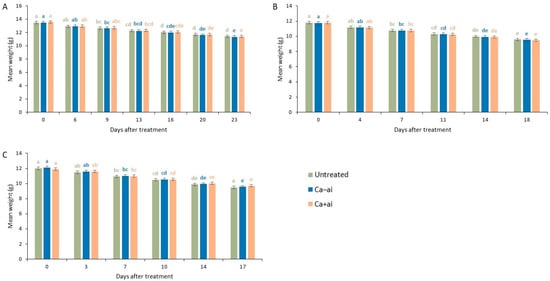
Figure 1
Open AccessArticle
Evaluation of Diverse Sorghum for Leaf Dhurrin Content and Post-Anthesis (Stay-Green) Drought Tolerance
by
Chad Hayes, Yves Emendack, Jacobo Sanchez, John Burke, N. Ace Pugh, Zhanguo Xin and William Rooney
Crops 2023, 3(3), 241-250; https://doi.org/10.3390/crops3030022 - 21 Sep 2023
Abstract
Post-flowering drought tolerance (stay-green) in grain sorghum (Sorghum bicolor (L.) Moench) is an important agronomic trait in many arid and semiarid environments throughout the world. Stay-green has been associated with increased grain yields, as well as resistance to lodging and charcoal rot
[...] Read more.
Post-flowering drought tolerance (stay-green) in grain sorghum (Sorghum bicolor (L.) Moench) is an important agronomic trait in many arid and semiarid environments throughout the world. Stay-green has been associated with increased grain yields, as well as resistance to lodging and charcoal rot disease. Nonetheless, the relative effects of genotype, environment, and genotype × environment interactions are not well understood for this trait; similarly, the relationship between various leaf sugars and stay-green has not been sufficiently evaluated in diverse germplasm. Thus, the goals of this study were to determine the genotype, environment, and genotype by environment (GxE) effects for leaf dhurrin, sugars, and stay-green in ten diverse grain sorghum breeding lines, to evaluate the Pearson’s correlation coefficients (r) between these traits, and to determine entry-mean repeatability (R) for each of these traits. Of the compositional traits studied, we determined that leaf dhurrin had the highest correlation with the stay-green phenotypes (r = −0.62). We found that stay-green sorghum lines contained approximately 2–3 times as much dhurrin as non-stay-green lines, with B1778 containing the highest concentration of dhurrin (84.8 µg/cm2) and Tx7000 containing the least (20.9 µg/cm2). The differences between the environments for several of the traits were high, and all the traits examined had high repeatability (R = 0.89–0.92). These data demonstrate a relationship between leaf dhurrin and the stay-green phenotypes in sorghum, and further study will allow researchers to determine the causal effect that dhurrin has on post-flowering drought tolerance in sorghum.
Full article
(This article belongs to the Special Issue Abiotic Stress Tolerance in Perennial Crops)
►▼
Show Figures
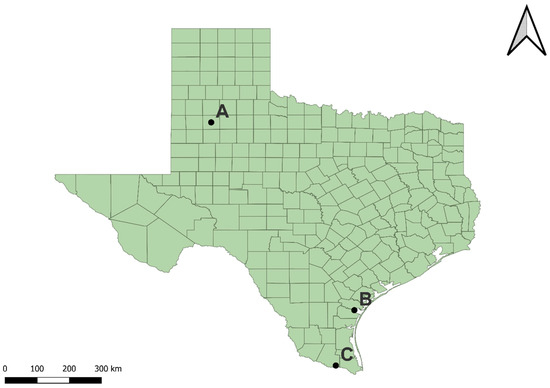
Figure 1
Highly Accessed Articles
Latest Books
E-Mail Alert
News
Topics
Topic in
Agronomy, Agriculture, Crops, Seeds
Advances in Industrial Crops Physioecology and Sustainable Cultivation
Topic Editors: Wei Hu, Zhiguo Zhou, Wenqing ZhaoDeadline: 30 April 2024
Topic in
Agriculture, Agronomy, Crops, Microorganisms, Plants, IJPB, Soil Systems
Microbe-Induced Abiotic Stress Alleviation in Plants
Topic Editors: Ying Ma, Christopher RensingDeadline: 30 September 2024
Topic in
Agronomy, Crops, Plants
Abiotic Stress Responses in Wheat: Perspectives on Productivity and Sustainability
Topic Editors: Wenshan Guo, Jinfeng Ding, Min ZhuDeadline: 31 October 2024
Topic in
Agriculture, Agronomy, Crops, Foods, Plants
The Future of Farming in a Changing World: From Physiology to Technology
Topic Editors: Giuseppe Ferrara, Olaniyi Amos FawoleDeadline: 1 December 2024

Conferences
Special Issues
Special Issue in
Crops
Biological Control in Food Crops
Guest Editors: María Villa, Filipe MadeiraDeadline: 25 July 2024

